Study on the Influence of Subway Tunnel Induced by Under-Crossing Tunnel Based on Monitor Data in Shenzhen, China
Abstract
:1. Introduction
2. Project Overview and Monitoring
2.1. Project Background
2.2. On-Site Monitoring Program
3. Results
3.1. Field Monitoring
3.2. Vertical Displacement of Vault
3.2.1. Before Crossing the Intersection Area
3.2.2. Under the Intersection Area
3.2.3. After Crossing the Intersection Area
3.3. Vertical Displacement of Track Bed
3.3.1. Before Crossing the Intersection Area
3.3.2. Under the Intersection Area
3.3.3. After Crossing the Intersection Area
4. Discussion
4.1. Critical Moments during Under-Crossing
4.2. Deformation of the Subway Tunnel of Line 11
5. Conclusions
Author Contributions
Funding
Data Availability Statement
Acknowledgments
Conflicts of Interest
References
- He, C.; Su, Z.X.; Zeng, D.Y. Influence of metro shield tunneling on existing tunnel directly above. China Civ. Eng. J. 2008, 3, 91–98. (In Chinese) [Google Scholar] [CrossRef]
- Fang, Q.; Du, J.; Li, J.; Zhang, D.; Cao, L. Settlement characteristics of large-diameter shield excavation below existing metro in close vicinity. J. Cent. South Univ. 2021, 28, 882–897. [Google Scholar] [CrossRef]
- He, Z.K. Influence of Shield Tunnel of Hangzhou Metro Line 5 on Pile-Raft Foundation of Existing Hangzhou South Railway Station and Construction Control Technology. Tunn. Constr. 2022, 42, 222–231. (In Chinese) [Google Scholar]
- Li, C.; Zhong, Z.; He, G.; Liu, X. Response of the ground and adjacent end-bearing piles due to side-by-side twin tunnelling in compound rock strata. Tunn. Undergr. Space Technol. 2019, 89, 91–108. [Google Scholar] [CrossRef]
- Liu, W.; Liang, J.; Xu, T. Tunnelling-induced ground deformation subjected to the behavior of tail grouting materials. Tunn. Undergr. Space Technol. 2023, 140, 105253. [Google Scholar] [CrossRef]
- Büchel, B.; Partl, T.; Corman, F. The Disruption at Rastatt and its Effects on the Swiss Railway System. In Proceedings of the 8th International Conference on Railway Operations Modelling and Analysis (ICROMA), Norrköping, Sweden, 17–20 June 2019. [Google Scholar]
- Kim, S.H.; Burd, H.J.; Milligan, G.E. Interaction between closely spaced tunnels in clay. In Geotechnical Aspects of Underground Construction in Soft Ground; CRC Press: Boca Raton, FL, USA, 1996; pp. 543–548. [Google Scholar] [CrossRef]
- Byun, G.W.; Kim, D.G.; Lee, S.D. Behavior of the ground in rectangularly crossed area due to tunnel excavation under the existing tunnel. Tunn. Undergr. Space Technol. 2006, 21, 361. [Google Scholar] [CrossRef]
- Choi, J.-I.; Lee, S.-W. Influence of existing tunnel on mechanical behavior of new tunnel. KSCE J. Civ. Eng. 2010, 14, 773–783. [Google Scholar] [CrossRef]
- Marshall, A.M.; Farrell, R.; Klar, A.; Mair, R. Tunnels in sands: The effect of size, depth, and volume loss on greenfield displacements. Géotechnique 2012, 62, 385–399. [Google Scholar] [CrossRef]
- Lin, Q.; Lu, D.; Lei, C.; Tian, Y.; Gong, Q.; Du, X. Model test study on the stability of cobble strata during shield under-crossing. Tunn. Undergr. Space Technol. 2021, 110, 103807. [Google Scholar] [CrossRef]
- Xie, X.; Yang, Y.; Ji, M. Analysis of ground surface settlement induced by the construction of a large-diameter shield-driven tunnel in Shanghai, China. Tunn. Undergr. Space Technol. 2016, 51, 120–132. [Google Scholar] [CrossRef]
- Kimmance, J.P.; Lawrence, S.; Hassan, O.; Purchase, N.J.; Tollinger, G. Observations of deformations created in existing tunnels by adjacent and cross cutting excavations. In Proceedings of the International Symposium on Geotechnical Aspects of Underground Construction in Soft ground, London, UK, 15–17 April 1996; pp. 707–712. [Google Scholar]
- Shao, H.; Zhang, Z.X. Analysis of disturbing effect on running metro caused by adjacent shield-driven. Rock Soil Mech. 2004, 25, 545–549. [Google Scholar] [CrossRef]
- Zhang, C.P.; Zhang, D.L.; Luo, J.J.; Wang, M.S.; Wu, J.P. Remote monitoring system applied to the construction of metro station undercrossing existing metro tunnel. Rock Soil Mech. 2009, 6, 1861–1866. [Google Scholar] [CrossRef]
- Mohamad, H.; Bennett, P.J.; Soga, K.; Mair, R.J.; Bowers, K. Behavior of an old masonry tunnel due to tunnelling-induced ground settlement. Géotechnique 2010, 60, 927–938. [Google Scholar] [CrossRef]
- Fang, Q.; Zhang, D.; Li, Q.; Wong, L.N.Y. Effects of twin tunnels construction beneath existing shield-driven twin tunnels. Tunn. Undergr. Space Technol. 2015, 45, 128–137. [Google Scholar] [CrossRef]
- Jin, D.; Yuan, D.; Li, X.; Zheng, H. An in-tunnel grouting protection method for excavating twin tunnels beneath an existing tunnel. Tunn. Undergr. Space Technol. 2018, 71, 27–35. [Google Scholar] [CrossRef]
- Jin, D.; Yuan, D.; Liu, S.; Li, X.; Luo, W. Performance of Existing Metro Tunnels Undercrossed by Four Closely Spaced Shield Tunnels. J. Perform. Constr. Facil. 2019, 33, 04018099. [Google Scholar] [CrossRef]
- Addenbrooke, T.I.; Potts, D.M. Twin Tunnel Interaction: Surface and Subsurface Effects. Int. J. Geomech. 2001, 1, 249–271. [Google Scholar] [CrossRef]
- Ng, C.W.W.; Fong, K.Y.; Liu, H.L. The effects of existing horseshoe-shaped tunnel sizes on circular crossing tunnel interactions: Three-dimensional numerical analyses. Tunn. Undergr. Space Technol. 2018, 77, 68–79. [Google Scholar] [CrossRef]
- Xue, F.; Zhang, M. Excavation Face Stability of Shield Tunneling Closely Under Existing Tunnels: Particle Flow Simulation. Iran. J. Sci. Technol. Trans. Civ. Eng. 2020, 44, 497–506. [Google Scholar] [CrossRef]
- Do, N.A.; Dias, D.; Golpasand, M.-R.B.; Dang, V.K.; Nait-Rabah, O.; Pham, V.V.; Dang, T.T. Numerical analyses of twin stacked mechanized tunnels in soft grounds—Influence of their position and construction procedure. Tunn. Undergr. Space Technol. 2022, 130, 104734. [Google Scholar] [CrossRef]
- Zhang, Z.G.; Huang, M.S.; Wang, W.D. Analysis on response of existing tunnels due to adjacent tunneling in multi-layered soils. Chin. J. Geotech. Eng. 2009, 31, 600–608. [Google Scholar] [CrossRef]
- Lai, H.P.; Zheng, H.W.; Chen, R.; Kang, Z.; Liu, Y. Settlement behaviors of existing tunnel caused by obliquely under-crossing shield tunneling in close proximity with small intersection angle. Tunn. Undergr. Space Technol. 2020, 97, 103258. [Google Scholar] [CrossRef]
- Zhang, Z.G.; Huang, M.S.; Wang, W.D.; Zhang, M.X. Deformation analysis of existing pipe traversed vertically by tunneling in layered soil: Comparison between coupling method and two-stage method. Rock Soil Mech. 2010, 31, 229–235. [Google Scholar] [CrossRef]
- Liang, R.; Xia, T.; Hong, Y.; Yu, F. Effects of above-crossing tunnelling on the existing shield tunnels. Tunn. Undergr. Space Technol. 2016, 58, 159–176. [Google Scholar] [CrossRef]
- Wei, G.; Qi, Y.J.; Wu, H.J.; Hua, X.X.; Zhang, Y.Z. Changes in circumferential pressure and stresses in existing tunnels caused by tunnel crossing. J. Cent. South Univ. (Sci. Technol.) 2020, 3515–3527. [Google Scholar] [CrossRef]
- Liu, S.H. Analysis on the difference of geological survey between mining method and shield method in Qianhai deep tunnel project. Urban Geol. 2022, 362–369. (In Chinese) [Google Scholar] [CrossRef]
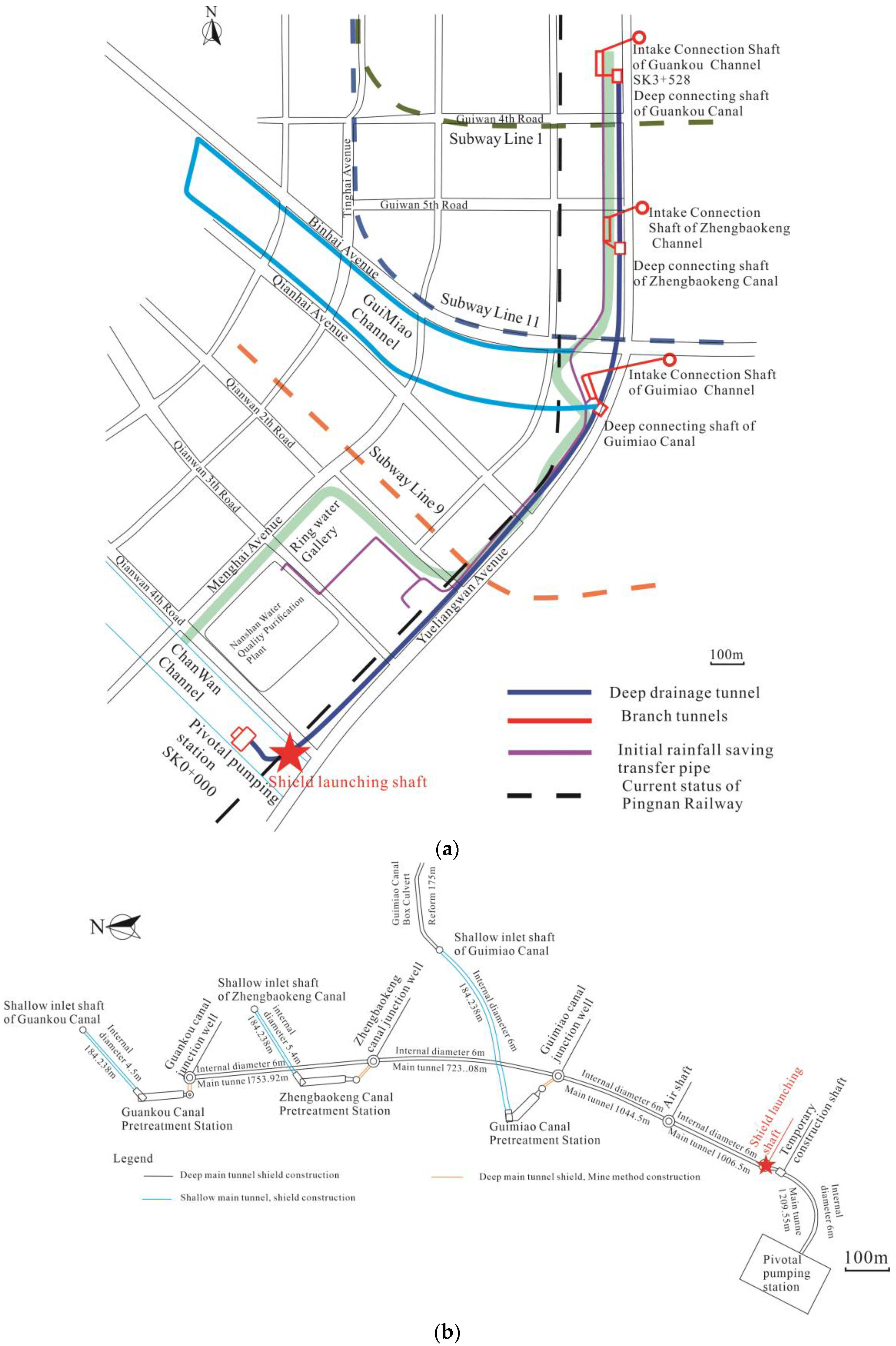
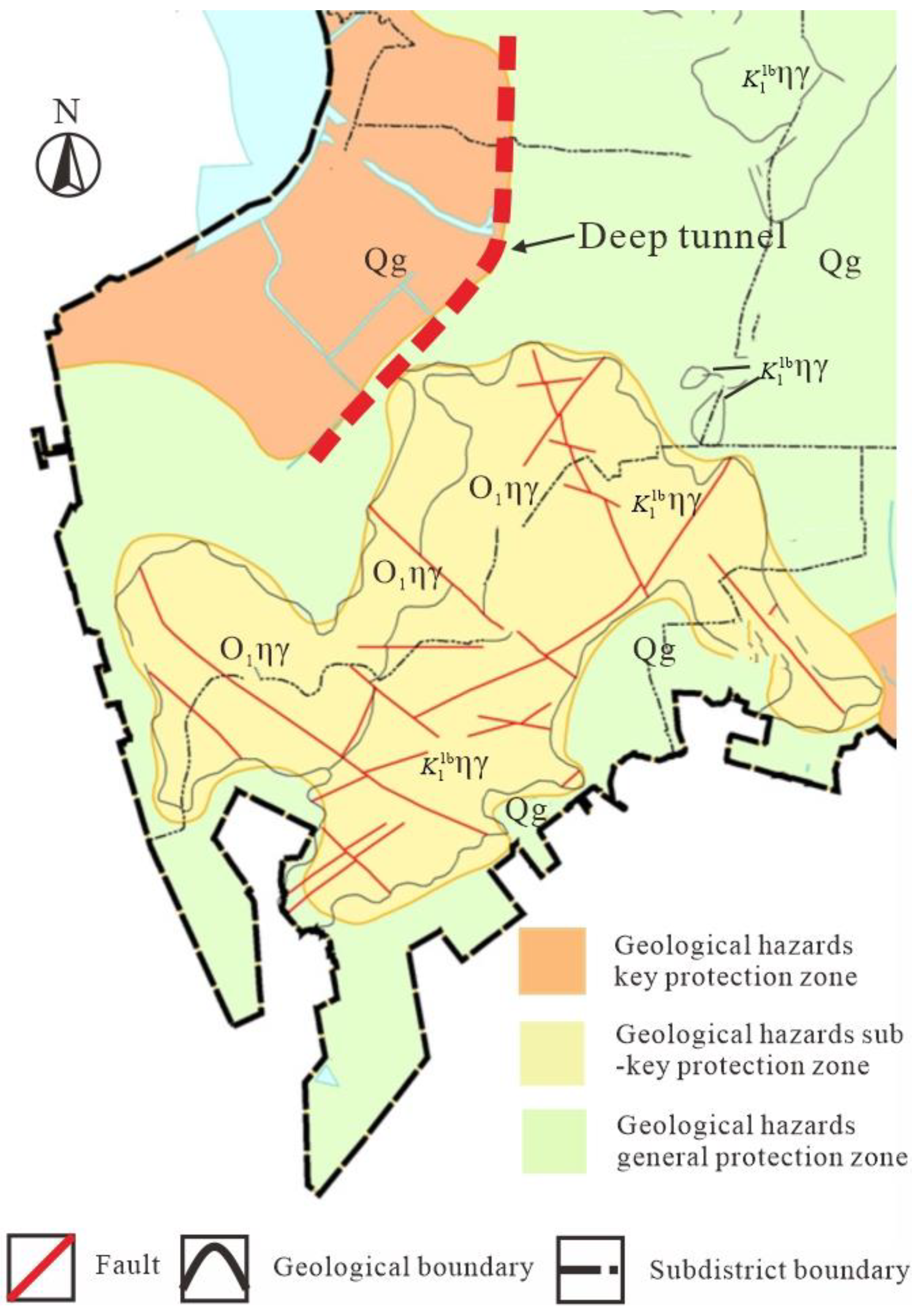

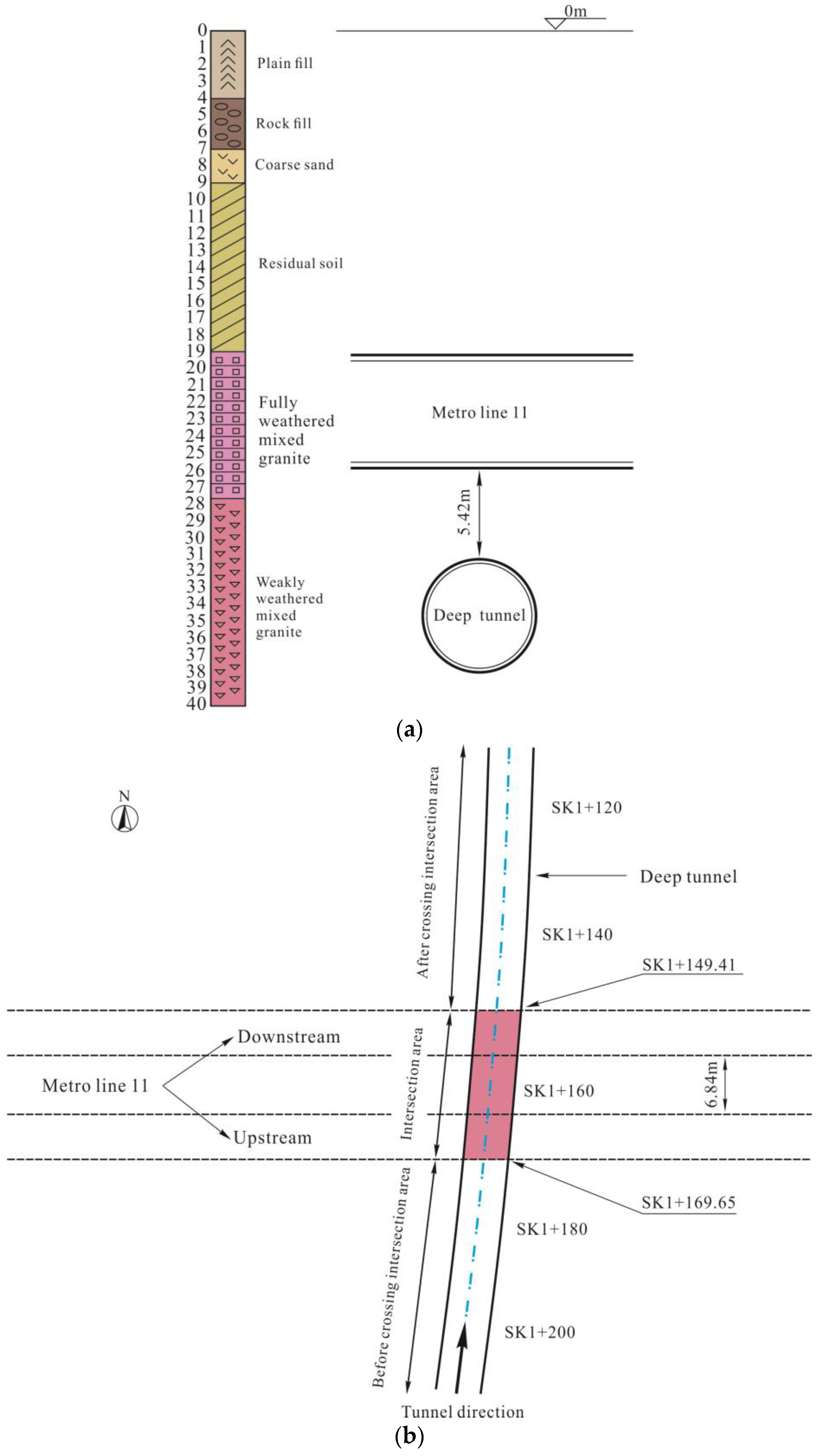

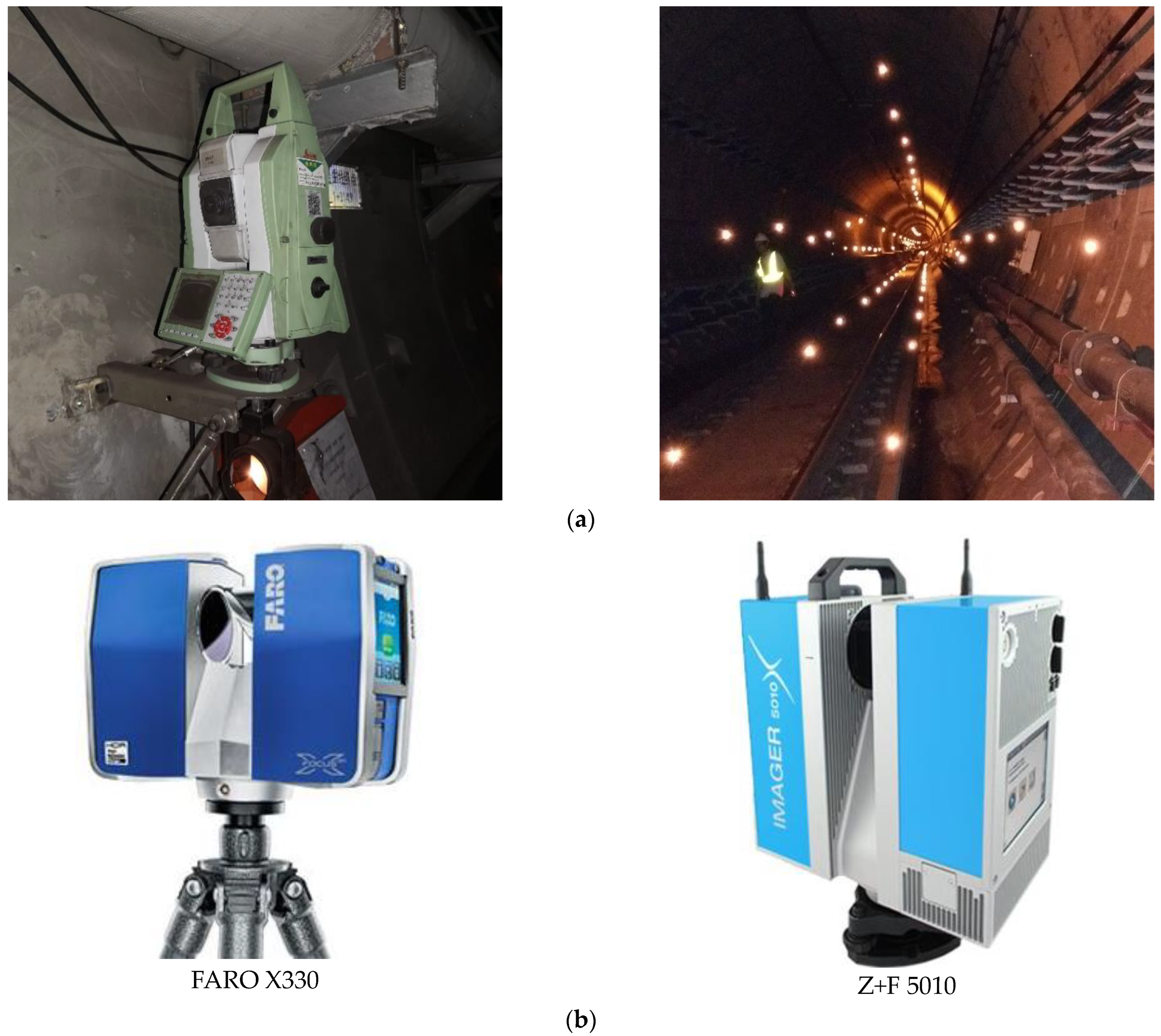



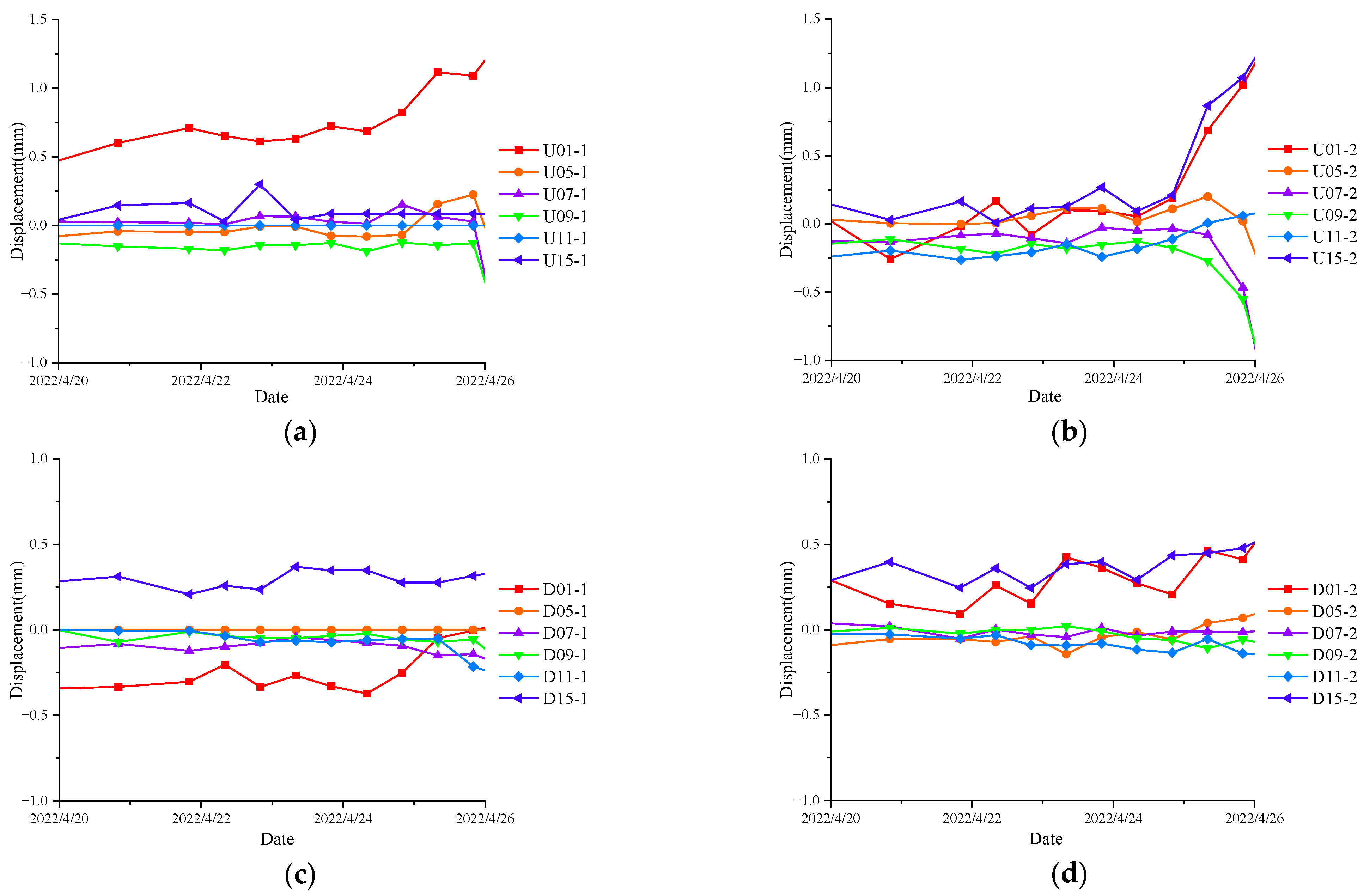

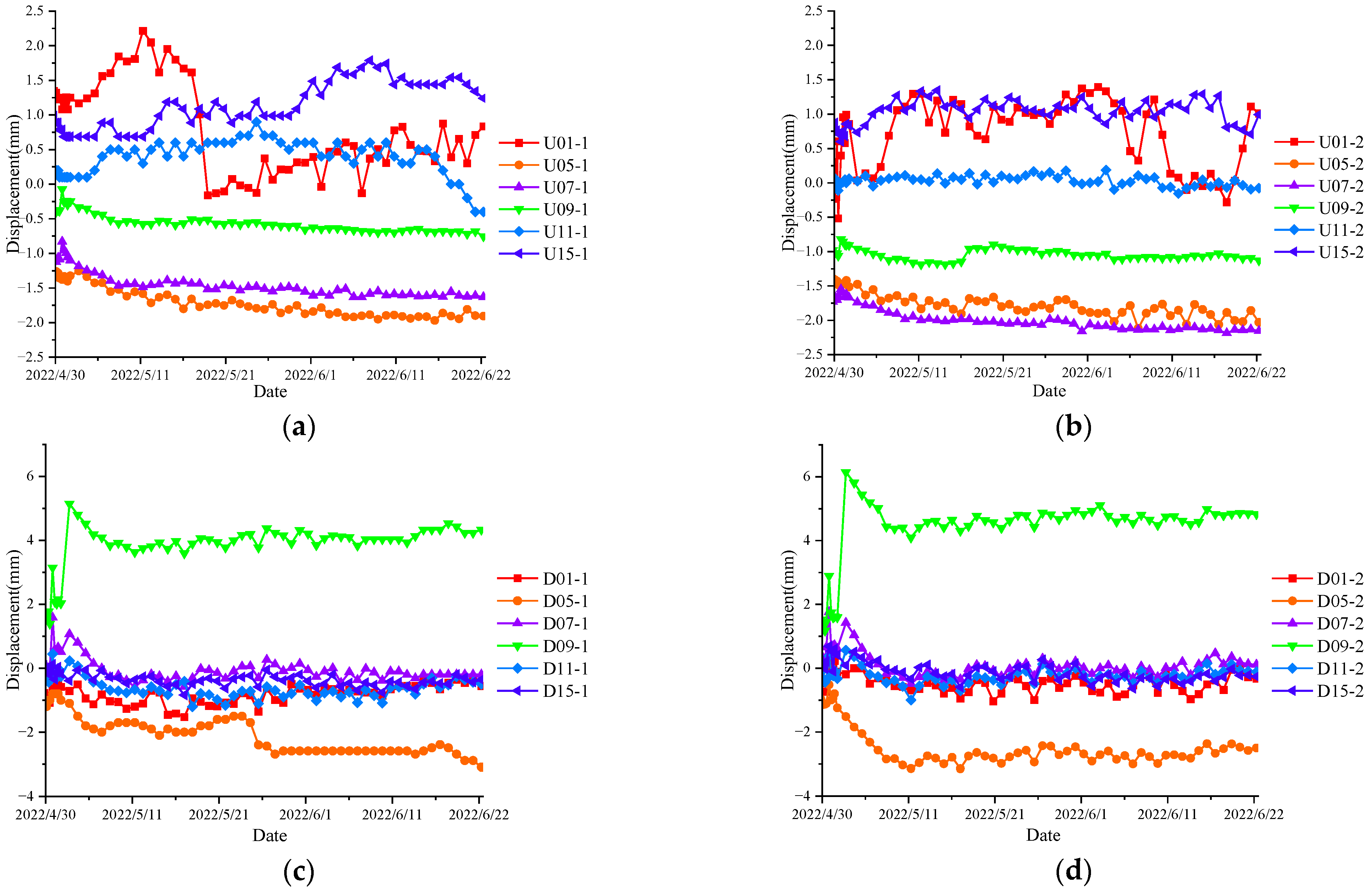
| Strata | Density (g/cm3) | Coefficient of Compressibility (MPa−1) | Compression Modulus (MPa) | Cohesion (kPa) | Friction (°) |
|---|---|---|---|---|---|
| Plain fill | 1.86 | 0.4 | 5 | 15 | 12 |
| Rock fill | 2.00 | - | 4 | 0 | 25 |
| Residual soil | 1.87 | 0.45 | 35 | 20 | 17 |
| Fully weathered mixed granite | 1.94 | 0.3 | 87 | 25 | 25 |
| Strongly weathered mixed granite | 2.00 | 0.1 | 125 | 35 | 26.6 |
| Weakly weathered mixed granite | 2.54 | - | 1000 | 35 | 26.5 |
| Safety Control Indicators | Early Warning (mm) | Alarm (mm) | Control (mm) |
|---|---|---|---|
| Horizontal displacement of tunnel | 6 | 8.5 | 10 |
| Vertical displacement of tunnel | 6 | 8.5 | 10 |
| Radial convergence of tunnel | 6 | 8.5 | 10 |
Disclaimer/Publisher’s Note: The statements, opinions and data contained in all publications are solely those of the individual author(s) and contributor(s) and not of MDPI and/or the editor(s). MDPI and/or the editor(s) disclaim responsibility for any injury to people or property resulting from any ideas, methods, instructions or products referred to in the content. |
© 2023 by the authors. Licensee MDPI, Basel, Switzerland. This article is an open access article distributed under the terms and conditions of the Creative Commons Attribution (CC BY) license (https://creativecommons.org/licenses/by/4.0/).
Share and Cite
Zhang, X.; Tan, H.; Liu, Z.; Dong, J.; Liu, S. Study on the Influence of Subway Tunnel Induced by Under-Crossing Tunnel Based on Monitor Data in Shenzhen, China. Sustainability 2023, 15, 13232. https://doi.org/10.3390/su151713232
Zhang X, Tan H, Liu Z, Dong J, Liu S. Study on the Influence of Subway Tunnel Induced by Under-Crossing Tunnel Based on Monitor Data in Shenzhen, China. Sustainability. 2023; 15(17):13232. https://doi.org/10.3390/su151713232
Chicago/Turabian StyleZhang, Xingsheng, Haicheng Tan, Zihui Liu, Jinyu Dong, and Shipeng Liu. 2023. "Study on the Influence of Subway Tunnel Induced by Under-Crossing Tunnel Based on Monitor Data in Shenzhen, China" Sustainability 15, no. 17: 13232. https://doi.org/10.3390/su151713232
APA StyleZhang, X., Tan, H., Liu, Z., Dong, J., & Liu, S. (2023). Study on the Influence of Subway Tunnel Induced by Under-Crossing Tunnel Based on Monitor Data in Shenzhen, China. Sustainability, 15(17), 13232. https://doi.org/10.3390/su151713232






